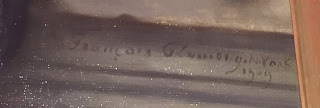Recently, our neighbors at the Vanderbilt Mansion National Historic Site had to change part of their narrative when they discovered Louise Vanderbilt's true age. For many years, Louise was thought to be twelve years older than Frederick, which was said to be part of the reason they did not have any children and married in secret (in addition to the fact that Louise was divorced from Frederick's cousin). Records on Louise were thin and several had conflicting information, but after extensive research by staff members, Louise's birth date was finally uncovered indicating that she was only eighteen months older than her husband!
We have a similar story of discovery here at Staatsburgh. For many years, the large portrait of Mrs. Mills, currently located in the boudoir, was attributed to a mysterious artist named François Glamony. An internet search for François Glamony, only locates links related to Staatsburgh and Staatsburgh's programs. This information had come directly from the site and there was nothing to indicate any history, background, or other works done by Glamony. Did Glamony actually exist?
 |
| Portrait of Ruth Livingston Mills, 1909 |
For many years, the site's records, signs, placards, and talks have all attributed the portrait of Ruth Mills to this artist. The need to check the validity of Glamony as artist may not have occurred to the individuals involved because the painting was signed. Clear as day, the portrait looks to be painted by Francois Glamony in New York in 1909. We can only assume that the folks originally inspecting the painting did their best to read the signature. At that point, they were not able to do a quick and easy search on the internet to verify his identity.
 |
| At first glance, the signature on Mrs Mills' portrait looks to read: François Glamony New York 1909 |
However, upon locating the painting in an online database of the Library of Congress (see here), I discovered a photographic print of the painting that stated the artist was François Flameng. Googling Flameng immediately locates his biography along with countless examples of his paintings. After taking a look through several of his paintings which included his signature, I discovered a few that looked very similar to his signature on the Staatsburgh painting. It was clear how the letter 'F' could have been mistaken for a 'G'. I knew I was onto something. This was our artist! Flameng even had his own wikipedia page! All of the information about Flameng lined up. He was a French painter who lived from 1856-1923 and many of his paintings were portraits that were stylistically quite similar to the portrait of Mrs. Mills. It was clear that these works were from the same artist.
 |
| Portrait of Mrs. Meunier, by François Flameng, 1907 |
 |
| Portrait of Madame D by François Flameng, 1910 |
There is a strong similarity between Mrs Mills' portrait and the two Flameng portraits shown above. The clothing, jewelry, and hairstyle are very prominent while the background is rather nondescript. One of the most notable portraits that Flameng painted was that of Queen Alexandra, wife of England's King Edward VII. Painted in 1908, the layers of chiffon and tulle surrounding the queen give her an ethereal quality. The portrait was exhibited in 'A Selection of Portraits by Francois Flameng of Ladies Well Known in Society' at Agnews before hanging in Windsor Castle. One of Flameng's earlier portraits was Queen Alexandra's younger sister, Maria Feodeorovna, the wife of Russia's Tsar Alexander III, so that connection is one possible reason why he received this commission.
 |
| Queen Alexandra, Portrait by François Flameng, 1908 |
 |
| Maria Feodoronva, Portrait by François Flameng, 1894 |
Ruth Mills aspired to be the "queen" of American society so it makes sense that she would have her portrait made by an artist who had just painted the Queen of England. Ruth's sister and Ogden's sister both had close connections to England's royal family and the Mills had attended functions with all of them. Certainly, a connection to the European aristocracy was used as another status symbol in high society. In fact, Ruth's daughter Beatrice had married the Earl of Granard in 1909, the same year that Flameng painted her portrait. Now knowing the artist of this portrait reveals several new avenues for exciting new research. Incidentally, finding the true artist of this painting was not the only discovery that we made. Stay tuned for Part II!

Great post! Very interesting.
ReplyDeleteThank you for the interesting new research! I think your meant to say that Empress Maria Feederovna was married to Tsar Alexander III.
ReplyDeleteI did...good catch! Fixed now :)
Delete